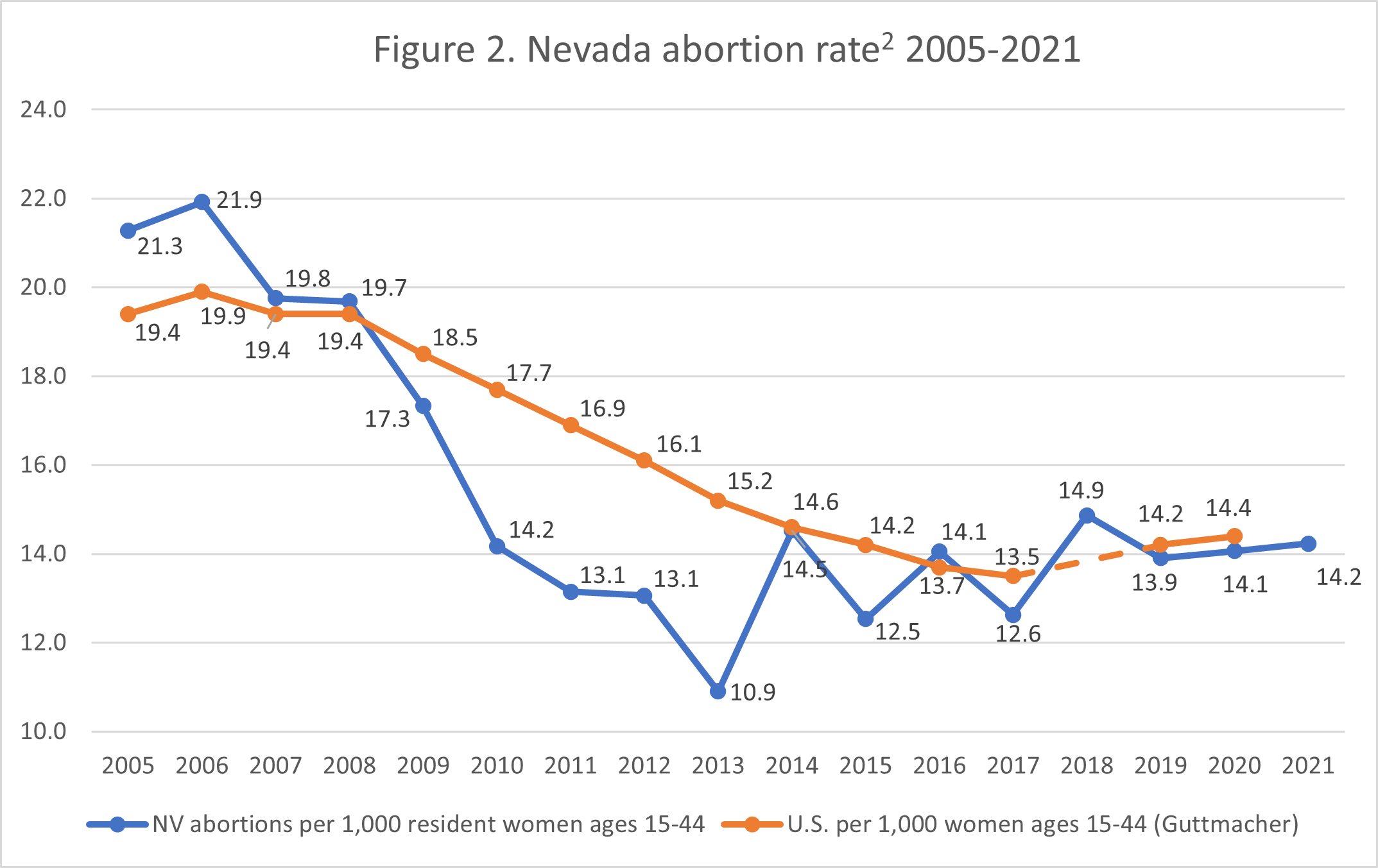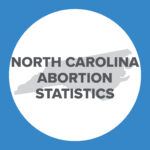Abortion Reporting: Nevada (2021)
Nevada’s 2021 abortion statistics were provided to the Charlotte Lozier Institute (CLI) by the Nevada Department of Health and Human Services upon request. The report shows that total abortions as well as the total number of chemical abortions that occurred in the state slightly increased from 2020.
Statistics and Changes in Nevada Abortions, 2020-2021

Abortion Totals and Trends
In 2021, there were 8,751 abortions reported in Nevada, an increase of 1.4 percent from the previous year (Fig. 1). There were 8,189 abortions performed in Nevada on state residents, less than a one percent increase from 2020. Just over half (51 percent) of the abortions performed in Nevada (4,426 abortions) were chemical, with the total number of chemical abortions occurring in the state increasing by 1.1 percent from the previous year. CLI estimates that Nevada’s 2021 abortion rate was 14.2 abortions per 1,000 women of childbearing age (Fig. 2). As of June 2023, 31 states have released 2021 abortion statistics, with 22 states reporting that abortions have increased.
State Report Summary
Ninety-four percent of the abortions reported in Nevada in 2021 were performed on state residents. Six percent or 546 abortions reported in Nevada were performed on nonresidents. Sixteen abortions occurred on women of unknown residence status.
A majority of the abortions (55 percent) were obtained by women in their twenties, with 28 percent on women ages 20 to 24 and 27 percent on women ages 25 to 29. Thirty-one percent were performed on women in their thirties, and four percent were on women in their forties, while eight percent of the abortions were performed on girls ages 19 and younger, including three percent on girls under the age of 18. The youngest girl to get an abortion was 13, and the oldest woman was 49. Age was not reported for two percent of Nevada abortions.
Four percent of Nevada abortions were on women with less than a high school education, and 39 percent were on women with a high school diploma or GED. Fifteen percent were performed on women who had attended some college but did not obtain a degree. Twelve percent of Nevada abortions were on women with a college degree, and 30 percent were on women whose level of education was not reported.
Five percent of the abortions were reported to have been performed on married women, and 39 percent were performed on unmarried women. However, 56 percent of the abortions that occurred in Nevada were performed on women whose marital status was not reported. Forty-one percent of the abortions were performed on women with no children, while 22 percent were on women with one child and 36 percent were on women with two or more children.
In 2021, 45 percent of the abortions performed in Nevada were suction curettage procedures. Just over half (51 percent) were chemical, and four percent were conducted via dilation and evacuation. There were four sharp curettage abortions, three intra-uterine instillation abortions, and two hysterectomy/hysterotomy abortions.
Ninety-nine abortions (1.1 percent) were reported between one and four weeks of gestation. Thirty-eight percent occurred between five and six weeks of gestation, and 31 percent were performed between seven and eight weeks. Sixteen percent were performed between nine and 10 weeks of gestation, while five percent occurred between 11 and 12 weeks and another five percent were reported from 13 to 15 weeks of gestation. Three percent of the abortions were performed between 16 and 19 weeks, and one percent occurred at 20 weeks of gestation or later. The latest reported abortion was performed at 26 weeks of gestation. The gestational age was not reported for 39 abortions.
Abortion Centers in Nevada
Twenty-one percent of Nevada abortions were performed by Planned Parenthood – an increase from 14 percent in 2020 – (12 percent by Planned Parenthood’s West Charleston center and nine percent by the East Flamingo location). Seventy-nine percent of the abortions were performed by independent abortion centers. Twenty-eight percent of the abortions were performed by Birth Control Care Center, and 27 percent were reported by A-Z Women’s Center. West End Women’s Medical Group performed nine percent, and eight percent occurred at Women to Women Gynecology. Desert Inn Medical Center reported four percent of the abortions. Planned Parenthood’s Nevada abortion centers perform only chemical abortions, so it is likely that all the surgical abortions occurred at independent abortion centers.
For the first time since the state started producing abortion reports, the state reported that two telemedicine chemical abortion companies performed 51 abortions in the state in 2021: 46 abortions by IGH PLLC, which does business under the name Abortion On Demand, and five abortions by Carafem Telehealth.
Legislative Changes
While the state did not enact any changes to its 24-week gestational limit following the overturn of Roe v. Wade in June 2022, other abortion legislation has been signed into law. Inexplicably, newly elected Republican Governor Joe Lombardo signed Senate Bill 131 on May 30, 2023. The bill codifies an executive order, “Protecting Access to Reproductive Health Services in Nevada,” issued in summer 2022 by then-Governor Steve Sisolak (D). The executive order affirmed the state’s commitment to “long protected reproductive freedom.” Senate Bill 131 shields someone coming to Nevada from a pro-life state to receive an abortion, as well as the doctor performing the abortion, from prosecution and provides that abortionists in the state cannot lose their Nevada medical licenses for performing abortions in other states. SB 131 “prohibits the Governor from surrendering, or issuing a warrant of arrest for, a person in this State who is charged in another state with a criminal violation of the laws of that other state if the violation involves the provision or receipt of or assistance with certain reproductive health care services.” Furthermore, the bill also bars the state’s agencies from assisting other states with investigations and proceedings related to abortion services.
State Ranking
In 2016, CLI evaluated abortion reporting across the 50 states, the District of Columbia, and New York City, and ranked Nevada’s reporting at 38th best. Since then, Nevada has improved its reporting by making reports available upon request on a regular schedule, reporting additional data, and even reporting the number of telemedicine abortions that occur in the state, making it one of the first states to do so. Nevada could further improve its reporting and increase transparency by publishing its reports online, as most other states do. Nevada could also collect and report data on complications caused by abortion.


- Abortion occurrence totals were obtained from the Nevada Department of Health and Human Services upon request. Chemical abortion totals were obtained from CDC. 2010 was the first year of chemical abortion data that Nevada reported to CDC. Nevada later revised its 2016 abortion total after data was submitted to the CDC. Consequently, the 2016 abortion total Nevada shared with CLI (8,069 abortions) was far higher than that reported to CDC (7,284), so CDC’s 2016 Nevada chemical abortion total is not included in this graph.
- Rates were calculated by CLI using the following formula: (total number of abortions performed in Nevada ÷ number of resident women ages 15-44) x 1,000. Rates may differ slightly from previous CLI articles due to revised population estimates and abortion totals. Population estimates were obtained from the CDC WONDER database. Estimates for 2005-2009 are intercensal estimates of the July 1 resident population. Estimates for 2010-2020 are Vintage 2020 postcensal estimates of the July 1 resident population. Estimates were produced by the U.S. Census Bureau and the National Center for Health Statistics.




























